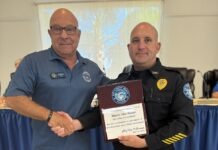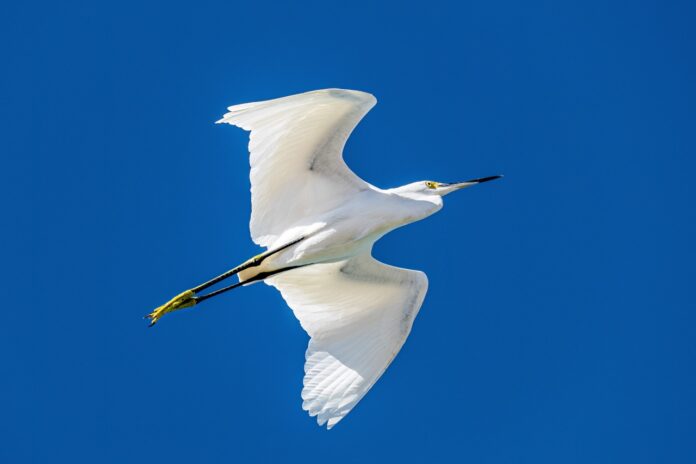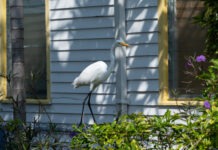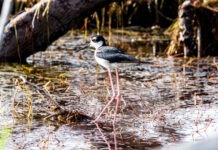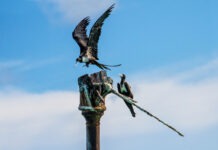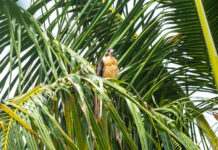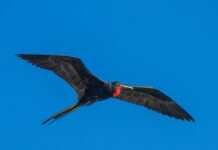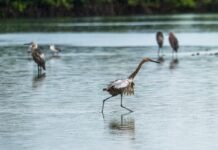What’s the difference between a heron and an egret? — KK on BPK
The Old High German word for heron was heiger, their name for the long-necked, long-legged wading birds. That evolved into the Old French word heiron, which evolved into the Middle English harn, then heiron, then heroun, which became the Modern English, heron. (Though you would expect the Brits to spell it heroun due to their penchant for uselessly adding a u to words. Colour me snarky.)
The word egret comes from the French aigrette, which also comes from the Old German heiger. The adaptation of the -ette suffix was a diminutive, to describe what is now called the little egret.
But none of this means anything. Since the two words rooted in Old German – the original OG – divided and began to replicate, they have been applied willy-nilly to various members of the heron family. There is no consistent rhyme or reason to it, just history and habit.
But just in case you were asking how to differentiate between some of our similar-looking local birds – the great egret and the great white heron – that is pretty easy. Great egrets have black legs. Great white herons have pale, flesh-colored legs.
How would birds like it if people took (poops) on their cars? — Elena of Stage and Screen
Elena. Birds don’t have cars. You must know this.
But for a second, suppose they did.
We have, as a species, not done right by them. We’ve decimated their habitat, turning much of the land they need to survive and thrive into strip malls, golf courses, parking lots and McMansions. We’ve let our pet cats roam free and kill an estimated 2.4 billion-with-a-b birds every year. (Free-roaming domestic cats have caused or contributed to the extinction of 63 species of mammals, reptiles and birds. So far.)
We’ve built giant shiny buildings, and installed uncountable sets of more modest sliding glass doors, all of which look like open sky to them, which birds slam into by the millions.
And I’m not going to go into all the terrible poems in which they’ve been forced to work, against their will, as vague metaphors for our ever-frail and self-centered human emotions.
Do you think for a second that if birds did, in fact, have cars, that we wouldn’t find a way to poop on them?
We’re lucky they didn’t go all Alfred Hitchcock on us years ago. Don’t get them mad by complaining too much about their tiny poops.
I just got a video of a snowy egret and I believe he was fishing with his yellow feet. Do they do that? — Beachfront Ward
According to science, or at least highly observant biologists, herons and egrets use a total of 34 different techniques to forage for dinner — usually fish, shrimp, worms or other small creepy-crawlies. Snowy egrets are thought to have the widest repertoire of moves, having been observed using 21 of those 34 techniques – tongue-flicking, head-swaying, pecking, walking quickly and leapfrog-feeding among them. What you’re describing sounds like either hover-stirring or foot-dragging. (The papers that described these tactics were published in the 1970s, and I couldn’t track down descriptions of exactly how those tactics were executed.)
Herons and egrets can’t actually catch fish with their feet, but what they can do is startle and confuse the fish, then snatch them up with their bills.
The first weekend I learned to identify snowy egrets (it’s the black legs and yellow feet) I was up in the Everglades at a place called Mrazek Pond. I saw snowies doing something I believe is similar to what you saw – the birds were flying low and slow over the water, dragging their toes across the surface like rakes, and then stabbing down at their toes with their bills, presumably trying to catch fish. I’ve seen a few thousand snowy egrets since, but I haven’t seen that behavior again. Pretty cool you got to see — and video — it.
Why do birds abandon their babies after someone touches their eggs? That seems extreme. — Dave the Ghost Hunter
It does seem extreme. But it’s okay – it’s a myth. It doesn’t actually happen.
Birds are eminently practical creatures. And they put a lot of effort and energy into mating, building a nest, laying eggs and tending to them. And they are not superstitious. If their eggs aren’t damaged, they are not going to view them as somehow sullied.
Suppose you climbed a tree, or used a ladder, found a nest, and like some bratty kid put your finger on each of the eggs just so you could say you touched them. Or even suppose you picked up each egg and held it gently for a moment before carefully replacing it in the nest – because only a rat bastard would damage an egg in the nest.
If a parent bird saw you, they would have one of two reactions. More aggressive species like osprey, kingbirds and mockingbirds would come at you. An osprey, with its razor-like talons, would try to mess you up, draw some blood. A kingbird or mockingbird would probably try and dive at you first, to intimidate you. And if that didn’t work, they might try landing on your head, pecking at you, pulling your hair, in an attempt to annoy you into leaving.
Birds like warblers or vireos, who are not aggressive but also probably know there is not much they could physically do to challenge you, would most likely lurk in the shadows, watching and waiting, hoping you did no damage, hoping they didn’t have to try and lay another clutch that season.
But if the parent bird did not see you, how would they know you were even there? Birds don’t have security cameras, and most have a terrible sense of smell. And even if they did smell something faint, they would not regard their eggs, their potential future offspring, as sullied. They would come back as soon as you exited the scene.
P.S. – It’s also a myth that birds will explode if they eat rice thrown at weddings. That’s just a lie perpetrated by the wedding industrial complex so they don’t have to sweep it all up after newlyweds leave the church.






